
The Federal District is one of 27 federative units of Brazil. Located in the Center-West Region, it is the smallest Brazilian federal unit and the only one that has no municipalities, being divided into 35 administrative regions. The federal capital of Brazil, Brasília, which is also the seat of government of the Federal District, is located in its territory. The Federal District is almost completely surrounded by the state of Goiás, but it shares a small border with Minas Gerais.

Porto Velho is the capital of the Brazilian state of Rondônia, in the upper Amazon River basin. The population is 548,952 people. Located on the border of Rondônia and the state of Amazonas, the town is an important trading center for cassiterite, the mining of which represents the most important economic activity in the region, as well as a transportation and communication center. It is on the eastern shore of the Madeira River, one of the main tributaries of the Amazon River. It is also Rondônia's largest city, and the largest state capital of Brazil by area.

Portuguese architecture refers to both the architecture of Portugal's modern-day territory in Continental Portugal, the Azores and Madeira, as well as the architectural heritage/patrimony of Portuguese architects and styles throughout the world, particularly in countries formerly part of the Portuguese Empire.
The Residence of Beco dos Redemoinhos, is a 14th-century building situated in the Portugueses civil parish of Cedofeita, Santo Ildefonso, Sé, Miragaia, São Nicolau e Vitória, municipality of Porto.

The Casa da Câmara is a former-administrative building located in the civil parish of Cedofeita, Santo Ildefonso, Sé, Miragaia, São Nicolau e Vitória, in the municipality of Porto, in northern Portugal.

The Convent of São Francisco, originally designated the Convent of Nossa Senhora da Vitória, located in the Largo of Nossa Senhora da Conceição, in the civil parish of Vila do Porto, municipality of the same name on the island of Santa Maria, in the Portuguese in the Azores.

The architecture of Póvoa de Varzim, in Portugal, demonstrates a broad variety of architectural styles over its thousand years of history. 11th-century Romanesque, 16th-century Mannerism, 18th-century Baroque, late 18th-century neoclassicism, early 20th-century Portuguese modernism and late 20th- to early 21st-century contemporary architectural styles and more are all represented in Póvoa de Varzim. As a whole it represents a rich eclectic tradition and innovation shaped by the people, their beliefs and economy.

The Church of Santa Bárbara is a Roman Catholic church in the civil parish of Santa Bárbara, municipality of Vila do Porto, in the archipelago of the Azores. Located in the valley of the same name, the parochial church of Santa Bárbara was constructed sometime in the early 15th century and served the impoverished parish throughout its history, supported by personal donations and community assistance.

The Cathedral of the Lord Good Jesus of the Remedies is a religious building affiliated to the Catholic Church located in the city of Afogados da Ingazeira, in the state of Pernambuco in the Northeast region of Brazil.

The Sacred Heart Cathedral or Cathedral of the Sacred Heart of Jesus and Christ the King, also Petrolina Cathedral, is a religious building affiliated with the Catholic Church located in the center of the city of Petrolina, in the state of Pernambuco in the northeastern region of the South American country of Brazil.

The Sacred Heart of Jesus Cathedral Also Ciudad Obregón Cathedral Is a Catholic church seat of the Diocese of Ciudad Obregón, in Mexico, is one of the most recent cathedrals of the country, since it was erected at the end of the 20th century. It is dedicated to the Sacred Heart of Jesus.

The Sacred Heart of Jesus Cathedral or Londrina Cathedral is a religious building belonging to the Catholic Church in the center of the city of Londrina, in northern Paraná state in the South American country of Brazil.
The Sacred Heart of Jesus Cathedral Also Uberaba Cathedral It is a Catholic church located in the city of Uberaba, in the state of Minas Gerais in Brazil. It is the seat of the Archdiocese of Uberaba, whose jurisdiction covers 20 municipalities in the Triângulo Mineiro and Alto Paranaíba.

The Portuguese Way is the name of the Camino de Santiago pilgrimage routes starting in Portugal. It begins at Porto or Lisbon. From Porto, along the Douro River, pilgrims travel north crossing the five main rivers—the Ave, Cávado, Neiva, Lima and Minho—before entering Spain and passing through Pontevedra on the way to Santiago de Compostela.

Lindomar Barbosa Alves better known as Lindomar Garçon is a Brazilian politician and pastor. Although born in Mato Grosso, he has spent his political career representing Rondônia, having served as state representative from 2007 to 2019.

Mariana Fonseca Ribeiro Carvalho de Moraes is a Brazilian politician. Although born in São Paulo she has spent her political career representing Rondônia, having served as federal deputy representative since 2015.

Jhonatan Pereira de Jesus is a Brazilian politician. He has spent his political career representing Roraima, having served as state representative since 2015.

Rodrigo Garcia is a Brazilian lawyer, businessman and politician, who was affiliated with the Brazilian Social Democracy Party (PSDB). He was state deputy elected for three consecutive legislatures, 1999–2002, 2003–2006 and 2007–2010, and president of the Legislative Assembly of São Paulo from 15 March 2005 to 15 March 2007. He had served as Governor of São Paulo from April to December 2022.
The Church of Saint Gonçalo is an early 20th-century Roman Catholic church in Cuiabá, Mato Grosso, Brazil. The church is dedicated to Saint Gundisalvus of Amarante and belongs to the Roman Catholic Archdiocese of Cuiabá. Saint Gonçalo a Portuguese Catholic priest beautified under Pope Pius IV in 1561. Saint Gonçalo found particular devoation in Brazil, with both churches and place names dedicated to the saint. The church was built in two phases: one in 1781 in a simple Portuguese colonial style; little documentation of the structure exists, although it was built at the same time as the Church of Our Lady of Santana do Sacramento in nearby Chapada dos Guimarães. The first church structure was demolished in the late 19th century and replaced by the Salesians with a Tuscan neoclassical structure with a tall spire. Church festivals dedicated to Saint Gonçalo, Mary, Our Lady Help of Christians, Saint Benedict, and the Sacred Heart of Jesus are held annually. The church was listed as a state-level listed historic structure by Mato Grosso in 1984.

















